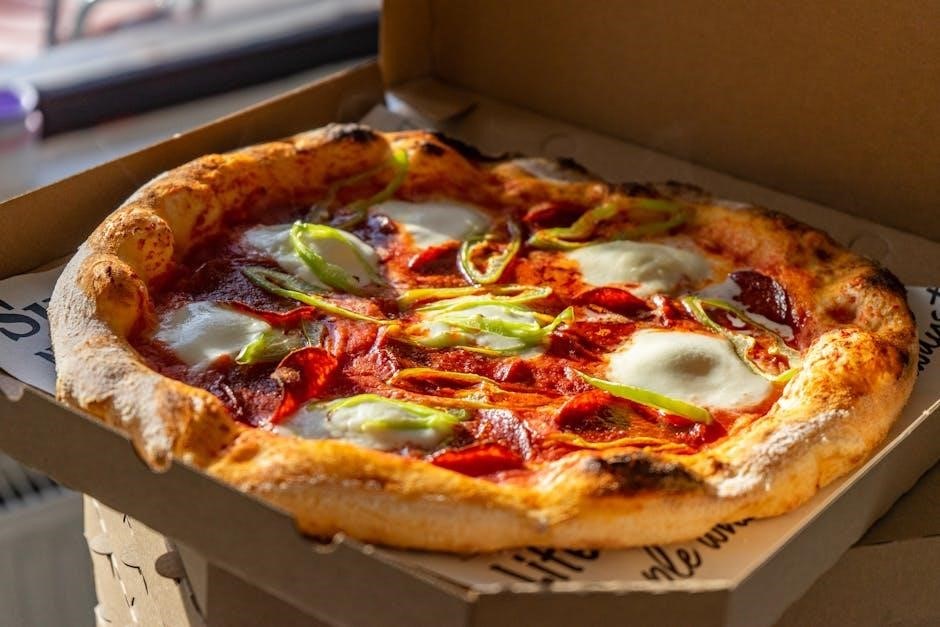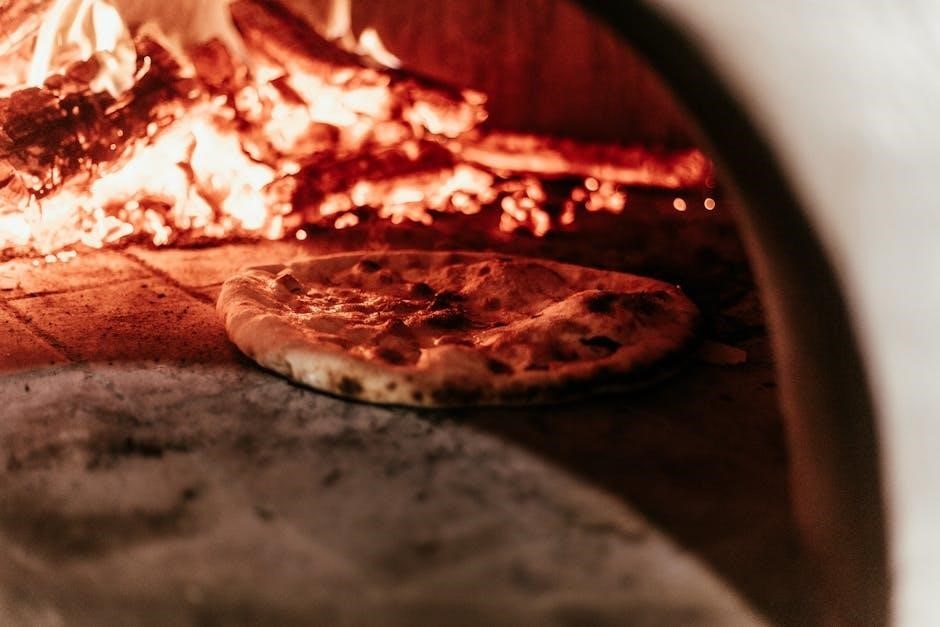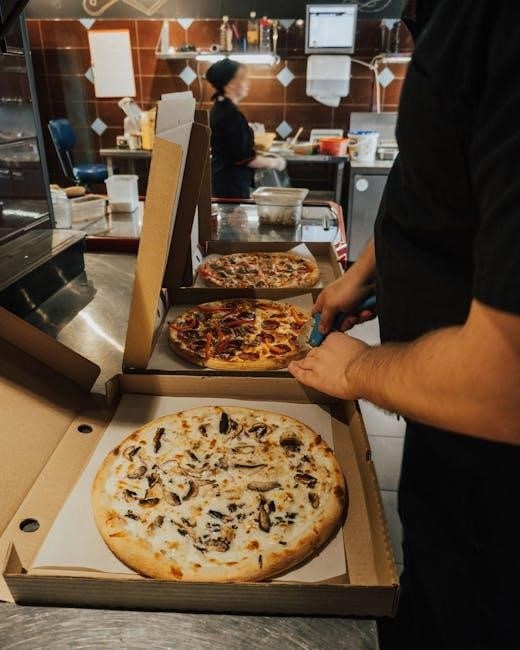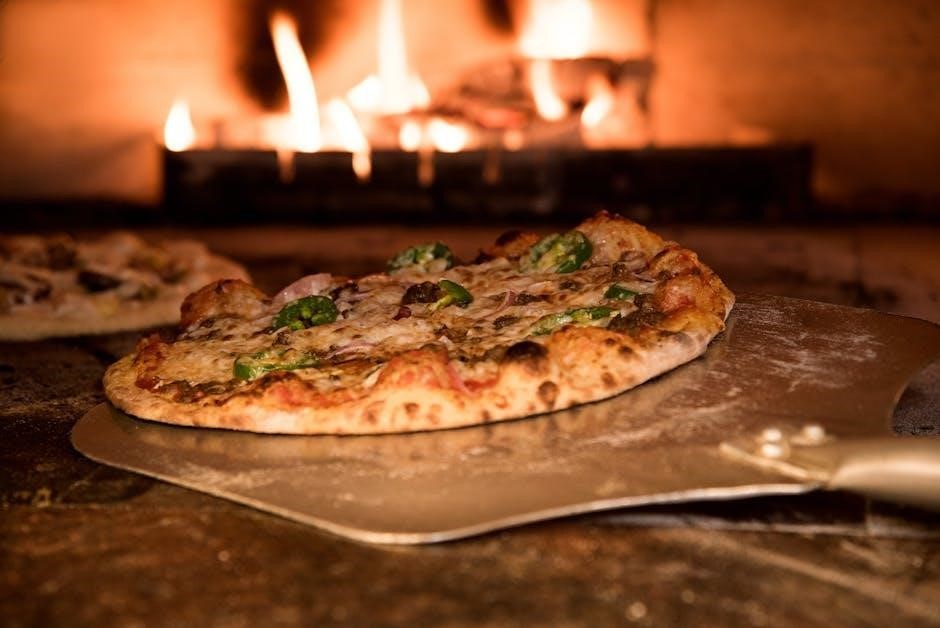Cauliflower pizza offers a modern twist on traditional pizza, using cauliflower as a low-carb, gluten-free crust alternative. It’s a healthier, innovative option for pizza lovers seeking fewer carbs and more nutrients.
1.1 What is Cauliflower Pizza?
Cauliflower pizza is a innovative, healthier alternative to traditional pizza, featuring a crust made from cauliflower. The crust is typically created by grating or food-processing cauliflower into a rice-like texture, then mixing it with ingredients like eggs and cheese to bind it together. This gluten-free and low-carb option is ideal for those seeking a diet-friendly meal without sacrificing flavor. The cauliflower crust is baked until crispy, providing a satisfying base for pizza sauce, cheese, and various toppings. Its popularity has grown due to its nutritional benefits and versatility, making it a favorite among health-conscious food enthusiasts and those with dietary restrictions.
1.2 Benefits of Cauliflower Pizza
Cauliflower pizza offers numerous health benefits, making it a popular choice for those seeking a more nutritious meal. It is naturally low in carbohydrates, making it an excellent option for individuals following a keto or low-carb diet. The cauliflower crust is also gluten-free, catering to those with gluten intolerance or sensitivity. Additionally, cauliflower is rich in vitamins, minerals, and antioxidants, providing a boost to overall health. Its lower calorie content compared to traditional pizza crusts makes it a guilt-free alternative. Furthermore, the versatility of cauliflower allows for creative variations, ensuring that dietary preferences, such as vegan or vegetarian, can be easily accommodated. This innovative dish combines health and flavor, appealing to a wide range of dietary needs and preferences.

Ingredients Needed for Cauliflower Pizza
Cauliflower, cheese, and seasonings form the base, while optional toppings like tomato sauce, herbs, and meats add flavor, creating a customizable and nutritious meal option.
2.1 Ingredients for the Cauliflower Crust
The cauliflower crust requires fresh or frozen cauliflower, which is grated and cooked to remove excess moisture; Essential ingredients include mozzarella or Parmesan cheese for binding, eggs for structure, and seasonings like garlic powder, salt, and pepper. Optional additions include oregano or Italian seasoning for flavor. For crispiness, some recipes incorporate a small amount of almond flour or coconut flour. Ensuring the cauliflower is well-drained after cooking is crucial to avoid a soggy texture. These simple ingredients combine to create a gluten-free, low-carb crust that mimics traditional pizza bases while offering a healthier alternative. Proper preparation of the cauliflower ensures a sturdy and flavorful base for toppings.
2.2 Pizza Sauce and Toppings
For the sauce, marinara or tomato puree is commonly used, offering a tangy base for toppings. Toppings can range from classic pepperoni and mushrooms to vegetarian options like olives, bell peppers, and onions. Fresh vegetables, such as spinach or cherry tomatoes, add vibrant flavor and texture. Cheese lovers can opt for mozzarella, Parmesan, or a blend for creamy coverage. Protein choices like grilled chicken or bacon enhance the pizza’s heartiness. Experiment with combinations to suit dietary preferences, ensuring not to overload the crust to maintain crispiness. A light layer of sauce and balanced toppings allow the cauliflower crust to shine while delivering a satisfying, customizable meal.
2.3 Additional Cheese and Seasonings
Additional cheese and seasonings elevate the flavor of cauliflower pizza. Sprinkle shredded mozzarella or Parmesan for creaminess, and consider blending with ricotta for a rich texture. Seasonings like oregano, basil, and garlic powder enhance the pizza’s aroma. For extra zing, add a pinch of red pepper flakes or a sprinkle of fresh herbs like parsley or cilantro. Optional additions include a drizzle of olive oil or balsamic glaze for a refined touch. Experiment with smoked paprika or dried thyme for a unique twist. Balancing flavors ensures the cauliflower crust remains the star while the toppings complement its natural taste, creating a delicious and satisfying meal.
Preparation Steps
Preparation involves prepping cauliflower, making the crust, and thawing or processing frozen cauliflower. These steps ensure a solid foundation for a delicious, well-structured cauliflower pizza.
3.1 Making Cauliflower Crust from Scratch
Making cauliflower crust from scratch involves grating cauliflower into rice-like texture, cooking it to soften, and squeezing out excess moisture. Mix with eggs, cheese, and seasonings, then shape into a circle or rectangle on parchment paper. Bake until golden and crispy before adding toppings. This method ensures a fresh, customizable crust.
3.2 Thawing and Preparing Frozen Cauliflower
Thaw frozen cauliflower by leaving it overnight in the fridge or thawing quickly by microwaving. Once thawed, pat dry to remove excess moisture. Pulse in a food processor until rice-like texture is achieved. Squeeze out moisture using a clean kitchen towel or cheesecloth. This step is crucial for a crispy crust. Mix with eggs, cheese, and seasonings before shaping and baking. Proper preparation ensures the crust holds together well and bakes evenly. Avoid skipping moisture removal to prevent a soggy texture.
3.3 Processing Cauliflower for the Crust
Processing cauliflower for the crust involves creating a rice-like texture. Pulse raw or thawed cauliflower in a food processor until finely grated. Transfer to a microwave-safe dish, cook for 4-5 minutes to soften, then let cool. Squeeze out excess moisture using a clean kitchen towel or cheesecloth—this step is vital for a crispy crust. Mix the drained cauliflower with eggs, cheese, and seasonings to bind the mixture. Shape into a circle on parchment paper, ensuring even thickness. Bake at 425°F for 15-20 minutes, or until golden and set, before adding toppings. This method ensures a sturdy, flavorful base for your pizza.

Cooking Methods
Cauliflower pizza can be cooked using various methods, including baking, grilling, or air frying, each offering a different texture and flavor profile for a customizable result.
4.1 Baking the Cauliflower Crust
Baking the cauliflower crust is a popular method that ensures a crispy texture. Preheat your oven to 425°F (220°C). Place the cauliflower crust on a baking sheet lined with parchment paper or a pizza stone for even cooking. Bake for 13-15 minutes, or until the crust is golden brown and the edges are crispy. To enhance crispiness, lightly brush the crust with olive oil before baking. Avoid overcrowding the crust with toppings during this step, as it may become soggy. Once baked, remove the crust from the oven and proceed to add your desired pizza sauce, cheese, and toppings before baking again until the cheese is melted and bubbly. This method yields a perfectly cooked crust with a delicious texture.
4.2 Grilling the Cauliflower Crust
Grilling the cauliflower crust adds a smoky flavor and a crispy texture. Preheat your grill to medium-low heat (around 375°F or 190°C). Place the cauliflower crust on a piece of aluminum foil or a pizza stone to prevent it from breaking. Cook for 5-7 minutes on each side, or until the crust is golden brown and slightly charred. Avoid high heat, as it can burn the crust quickly. Once grilled, remove the crust and top it with your favorite sauce, cheese, and toppings. Return it to the grill for an additional 2-3 minutes to melt the cheese and warm the toppings. This method creates a unique, smoky flavor that enhances the overall pizza experience.
4.3 Cooking in an Air Fryer
Cooking cauliflower pizza in an air fryer is a quick and efficient method. Preheat the air fryer to 400°F (200°C). Place the cauliflower crust in the air fryer basket, ensuring it fits without overlapping. Cook for 5-7 minutes, or until the crust is golden and crispy. Shake the basket halfway through to ensure even cooking. Once the crust is ready, add your preferred sauce, cheese, and toppings. Return to the air fryer for an additional 2-3 minutes to melt the cheese and warm the toppings. The air fryer method results in a crispy crust and evenly cooked toppings, making it a convenient option for a delicious homemade pizza.

Assembling and Topping the Pizza
Spread pizza sauce evenly over the cauliflower crust, then layer cheese and desired toppings. This step allows for personalization, ensuring a delicious, customizable pizza tailored to your taste preferences.
5.1 Spreading the Pizza Sauce
Spreading pizza sauce evenly over the cauliflower crust is crucial for flavor distribution. Use a spoon or brush to apply a thin, uniform layer, avoiding the edges if desired. Ensure the sauce doesn’t pool, as this can make the crust soggy. Traditional tomato sauce works well, but alternatives like pesto or white sauce can also be used for variety. Once the sauce is spread, it’s time to add cheese and toppings, creating a balanced and flavorful base for your cauliflower pizza.
5.2 Adding Cheese and Toppings
After spreading the sauce, it’s time to add cheese and toppings. Mozzarella is a popular choice for its melting properties, but you can also use parmesan, ricotta, or a blend. Sprinkle the cheese evenly over the sauce, ensuring it reaches the edges for a golden, bubbly finish. Toppings like pepperoni, vegetables, or meats can be added next. Keep toppings balanced to avoid overwhelming the crust. For a vegan option, dairy-free cheese alternatives work well. Avoid overly wet toppings to maintain crust crispiness. Once everything is in place, your cauliflower pizza is ready for baking, ensuring a delicious, customizable meal.

Baking Instructions
Preheat your oven to 425°F for optimal results. Bake the cauliflower pizza for 10-15 minutes until the crust is golden and the cheese is bubbly and melted.
6.1 Preheating the Oven
Preheating your oven is a crucial step for achieving a crispy cauliflower crust. Set your oven to 425°F (220°C) and allow it to heat for at least 10-15 minutes. This ensures even cooking and helps the crust brown properly. If using a pizza stone, place it inside the oven during preheating to enhance crispiness. Proper preheating prevents sogginess and promotes a well-cooked crust. Some recipes suggest higher temperatures, up to 450°F (230°C), for an extra crispy texture. Always refer to specific instructions for your oven model to ensure accuracy.
6.2 Baking Time and Temperature
Bake the cauliflower pizza at 425°F (220°C) for 15-20 minutes for a crispy crust. Some recipes recommend 450°F (230°C) for 10-12 minutes for extra crispiness. The crust should be golden brown, and the cheese melted and bubbly. Avoid overbaking to prevent the crust from drying out. If using a pizza stone, bake for 12-15 minutes. For a well-cooked crust, ensure the center is set and the edges are golden. Adjust time based on crust thickness and toppings. Always check for doneness by looking at the crust’s color and the cheese’s melt. Proper temperature and timing ensure a delicious, evenly cooked cauliflower pizza. Keep an eye during the last few minutes to avoid burning. Let it cool slightly before serving for the best texture.
6.3 Checking for Doneness
To ensure your cauliflower pizza is perfectly cooked, check for a golden-brown crust with crispy edges and a firm, set center. The cheese should be melted, bubbly, and slightly browned. Gently lift the pizza to inspect the bottom; it should be evenly cooked and not soggy. Avoid overcooking, as it can dry out the crust. If toppings are added, ensure they are heated through and any raw ingredients are fully cooked. The crust should hold its shape without flopping, indicating it’s done. Let it cool slightly before slicing to maintain crispiness and prevent sogginess. Proper doneness ensures a flavorful and textured cauliflower pizza experience. Always check visually and by texture for the best results.

Tips for the Best Results
Preheat the oven properly, press excess moisture from cauliflower, and bake at the right temperature. Avoid overloading with toppings for a crispy, evenly cooked crust.
7.1 Ensuring a Crispy Crust
To achieve a crispy cauliflower crust, preheat the oven to 425°F (220°C). Ensure the cauliflower is completely dry by squeezing out excess moisture. Bake the crust for 15-20 minutes until golden brown. For added crispiness, bake the crust for 5-7 minutes before adding toppings. Avoid overloading with toppings to prevent sogginess. Flipping the crust halfway through baking can enhance crispiness. Properly preheating the oven and using a baking sheet lined with parchment paper also contribute to a crispy texture. These steps ensure a delicious, well-textured cauliflower pizza crust.
7.2 Avoiding a Soggy Crust
A soggy crust can be prevented by thoroughly drying the cauliflower after processing. Excess moisture is a primary cause of sogginess. Use a clean dishcloth or cheesecloth to squeeze out as much water as possible from the grated cauliflower. Additionally, baking the crust at a high temperature, such as 425°F (220°C), helps evaporate moisture quickly. Avoid overloading the pizza with wet toppings, as this can also contribute to a soggy texture. Ensuring the oven is preheated adequately before baking is crucial. By following these steps, you can achieve a crust that is both crispy and flavorful, avoiding the common issue of sogginess in cauliflower pizza.
7.3 Achieving Even Cheese Distribution
For even cheese distribution, spread the cheese uniformly across the cauliflower crust. Start by sprinkling a thin layer of cheese over the sauce, then add toppings, and finish with another layer of cheese on top. This ensures the cheese melts evenly and covers the entire pizza. Avoid clumping the cheese in one area, as it can lead to uneven melting. Rotate the pizza halfway through the baking time to ensure consistent heat distribution. Using a moderate amount of cheese also helps prevent overcrowding, allowing each part to melt properly. Bake at 425°F (220°C) for 10–12 minutes, or until the cheese is golden and bubbly. This method guarantees a well-coated, evenly cheesy cauliflower pizza.

Nutritional Benefits
Cauliflower pizza is a low-carb, gluten-free option rich in vitamins, fiber, and antioxidants. It offers a healthier alternative to traditional pizza, supporting weight management and digestive health.
8.1 Low-Carb Alternative to Traditional Pizza
Cauliflower pizza serves as a game-changer for those seeking a low-carb alternative to traditional pizza. By substituting the usual flour-based crust with a cauliflower-based one, the carb content is significantly reduced. This makes it an ideal option for individuals following low-carb diets or managing dietary restrictions. The cauliflower crust is typically made by grating the vegetable, cooking it, and mixing it with eggs and cheese to bind it together. This method not only slashes carb intake but also retains a satisfying texture and flavor. It’s a healthier choice that aligns with modern dietary preferences, offering a guilt-free way to enjoy pizza without compromising on taste or satisfaction.
8.2 Gluten-Free Option
Cauliflower pizza crust is a fantastic gluten-free alternative, making it suitable for individuals with gluten intolerance or celiac disease. Traditional pizza crusts rely on wheat flour, which contains gluten, but cauliflower crusts are naturally gluten-free; This makes them an excellent option for those needing to avoid gluten without sacrificing flavor. The crust is typically made from grated cauliflower, eggs, and cheese, ensuring it holds together well while remaining gluten-free. Additionally, cauliflower crusts are versatile, allowing for a variety of toppings to suit different dietary preferences. This innovation has made pizza more accessible to people with gluten restrictions, offering a delicious and satisfying meal that aligns with their dietary needs. It’s a great way to enjoy pizza without the gluten, providing both convenience and flavor.
Common Mistakes to Avoid
Overcooking the crust and using excess moisture are common errors that can make the crust soggy. Ensure proper preparation and cooking techniques for the best results.
9.1 Overcooking the Crust
Overcooking is a common mistake that can make the cauliflower crust dry and unpalatable. It’s essential to monitor the cooking time closely, as the crust can quickly go from perfectly golden to burnt. Most recipes suggest baking the crust at around 425°F (220°C) for 15-20 minutes. However, this time may vary depending on your oven’s performance. To avoid overcooking, check the crust frequently during the last few minutes of baking. A well-cooked crust should be crispy on the edges and golden in color but still retain some softness in the center. Adjust the cooking time based on your oven’s temperature and the crust’s thickness for the best results.
9.2 Using Excess Moisture in the Crust
Excess moisture in the cauliflower crust can lead to a soggy, unappetizing texture that falls apart easily. This issue often arises when the cauliflower isn’t properly drained after cooking. To combat this, it’s crucial to squeeze out as much water as possible from the cooked cauliflower before mixing it with other ingredients. Using a clean kitchen towel or cheesecloth to press out excess moisture ensures a dryer crust. Additionally, avoid adding too much liquid-based sauce or excessive toppings, as this can reintroduce moisture. A well-balanced crust with minimal moisture will yield a crispy, flavorful base for your pizza.
- Always drain cooked cauliflower thoroughly.
- Avoid over-saucing or over-topping the pizza.

Variations and Creative Ideas
Cauliflower pizza invites endless creativity. Try vegetarian delights, fusion toppings, or unique sauces to craft a personalized pizza that suits every taste and dietary preference.
- Greek-style with feta and olives
- Mexican-inspired with salsa and avocado
- French-style with caramelized onions
10.1 Vegan Cauliflower Pizza
Vegan cauliflower pizza is a plant-based twist that skips dairy while retaining flavor. Use a cauliflower crust, vegan cheese, and plant-based milk for the sauce. Top with roasted vegetables, mushrooms, or spinach for added texture and nutrition; Key ingredients include nutritional yeast for a cheesy flavor and vegan-friendly seasonings. Instructions involve baking the crust until crispy, layering with sauce, and adding toppings before a final bake. This option is perfect for those avoiding dairy, offering a low-carb, gluten-free alternative. Experiment with flavors like pesto or hummus for a unique taste. Vegan cauliflower pizza is a versatile, guilt-free meal that caters to diverse dietary preferences while delivering satisfaction and creativity in every bite.
10.2 Meal Prep and Storage Tips
For meal prep, prepare the cauliflower crust in advance and store it in an airtight container in the fridge for up to 3 days or freeze for up to 2 months. Thaw frozen cauliflower thoroughly before use to avoid a soggy texture. Cooked cauliflower pizza can be refrigerated for 3-5 days or frozen for up to 2 months. Reheat in the oven at 350°F for 10-15 minutes to restore crispiness. Store toppings separately to maintain freshness. Label and date containers for easy meal planning. For the best results, bake the pizza immediately after assembling to ensure a crispy crust. Leftovers can be portioned and reheated as needed, making cauliflower pizza a convenient option for meal prep.
Cauliflower pizza is a delicious, nutritious alternative to traditional pizza, offering a low-carb and gluten-free option. Perfect for health-conscious foodies seeking a tasty, guilt-free meal solution.



